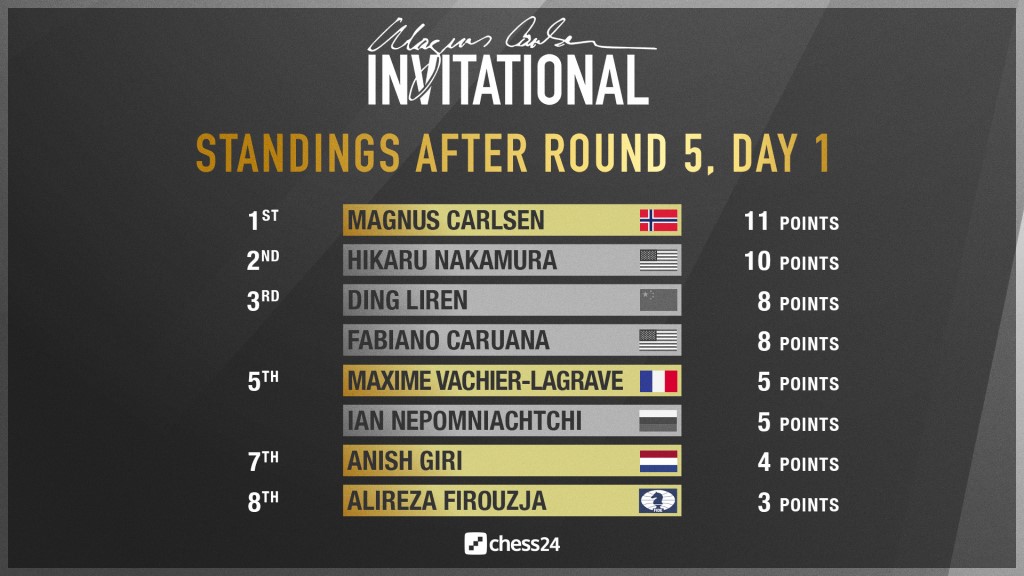


Given the strength of the line-up at the Magnus Carlsen Invitational, it was difficult to talk about underdogs before the start of the event — with the one exception of Alireza Firouzja perhaps, although the youngster's recent ascent made him more of an unpredictable participant instead of a dark horse. However, after four rounds, the 16-year-old and Anish Giri were having trouble scoring match points, despite showing strong play from time to time.
Thus, it was highly unlikely for both Giri and Firouzja to beat Carlsen and Vachier-Lagrave on the same day. Both managed though, and without needing tiebreaks. Vachier-Lagrave's loss was very good news for those in the hunt for a place among the semi-finalists — i.e. Nakamura, Ding, Caruana and Nepomniachtchi.
The winners of the day were interviewed after their matches. Giri noted that most people stopped believing in him after his subpar start, with one big exception:
The one person who [believes in me] is Magnus, because he invited me to the tournament — I think he did it because he thinks I'm a worthy player of this tournament. As long as he believes in me, I can still beat him on a good day.
Meanwhile, a humble Firouzja mentioned that being in the cellar of the standings table does not affect his motivation negatively:
I have no reason to not be motivated, because all these guys are very strong, and I want to play some good games, to get some experience.
There was room for some boasting nonetheless. The ever-witty Giri made reference to that time Carlsen used the confessional booth at the 2018 Sinquefield Cup...
Who does it better @MagnusCarlsen or @anishgiri ? 🤣@chess24com pic.twitter.com/FgIUAOei1c
— Aneet Arulanantham (@aneet_chess2000) April 26, 2020
Playing white, Giri opted for an Open Catalan in game one, which ended peacefully after 41 moves. In his first outing with black, the Dutchman went for the same sharp line used by Firouzja against Carlsen in round two. Giri deviated with 12...Bd6, to which Carlsen responded with an unexpected rook manoeuvre:
Giri later explained that Carlsen's 13.Rg1 is not shown by the computer as a first suggestion, as Black's threat of pushing his pawn to f4 seems to be the most important factor in this position. After thinking for over seven minutes — in a 15-minute game — Giri chose not to go for 13...f4 and played 13...0-0 instead. The game continued 14.h4 f4 15.gxf4 g4, when Black has huge potential to create threats.
With the white king stuck in the centre, Giri continued to up the pressure, until Carlsen faltered decisively on move 25:
White's 25.f3 is losing due to 25...Nxd3+ 26.Qxd3 Qc1+, gaining the rook. The commentators were shocked by Carlsen's blunder, but Giri later made a strong statement in this regard, noting that Black had built up a very strong setup prior to this point:
Why is everyone else allowed to blunder under pressure [except] him?
Carlsen resigned on move 33 and went on to play the Grünfeld with black in game three. Once again, Giri got a superior position:
Here White had 26.h6, increasing his edge. Giri went for 26.hxg6 instead, and later commented, explaining that he thought he had a tactically winning position:
Of course, h6 is just a strategic win — I didn't really think it was necessary to switch gears.
This game was drawn after 70 moves, which meant the Dutchman only needed a draw with the black pieces to secure match victory. He played the Najdorf, and perhaps got exactly what he wanted: a position in which he can, at the very least, force a draw by perpetual. A strong showing of tactical alertness gave Giri the coveted half point after 25 moves.
Select an entry to switch between games
This match was also decided by a single win with the black pieces. Firouzja showed he was in good form when he drew game one with black, despite his famed opponent creating plenty of tactical imbalances, looking for ways to outsmart the youngster. Then, the one getting the upper hand in game two was the Iranian, but a well-played encounter by both sides resulted in a 41-move draw.
The decisive game came in round three, when Vachier-Lagrave allowed his rival to get a dangerous passer on the a-file in a queenless position:
White did not feel the danger and went for 30.Rfd1 here, allowing 30...Rxa4, when the passed pawn is strongly supported by the a8-rook and the dark-squared bishop. 30.Nc5 was the way to go, looking to either continue defending the pawn or getting counterplay with the knight. After the text, Black needed only five more moves to push his opponent to resign.
Giri had already joined the commentary team when Firouzja was in the midst of his fourth game, and mentioned that playing in a must-draw situation is quite tricky. The Dutch grandmaster's statement was confirmed by the game in question, as Firouzja misplayed a superior position and ended up having to fight to get the all-important half point.
The 16-year-old played 41.Qf5 here, perhaps assessing that after 41...Qxa5 he had a perpetual check, when in fact Black can escape the checks and simply gain a piece — the natural 41.Bc3 was the way to go. The computer showed some lines that would have given Vachier-Lagrave the win in the remaining 47 moves, but Firouzja never stopped creating obstacles for his opponent. The youngster's online-blitz skills came to the fore and gave him the half point he needed to score his first match victory of the event.
Select an entry to switch between games

IM Lawrence Trent analysed the action of the day
The Magnus Carlsen Invitational is brought to you by chess24.com. Learn more about the tournament at magnuscarlsen.com/en/invitational